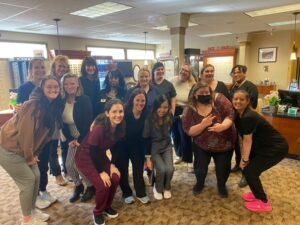
Dr. Patel’s practice team. He says that empowering employees, rather than micromanaging, getting to know team members, and getting regular feedback from them, have contributed to strong employee engagement.
By Raj Patel, OD, FAAO
April 12, 2023
After more than 25 years in practice, I have learned the value of employee engagement. It makes the difference between a staff that is going through the motions and employees who know how to work together, and with you, to attain shared goals. When you have a high level of employee engagement, delivering superior care, and growing profitability, becomes easier.
More than 30 percent of my 25-person team has been with us for over eight years. Twenty percent has been here for 10+ years. Our average retention is four years per employee over the last 20 years.
Here is how my practice, which achieved 4-7 percent revenue growth for 10 straight years, keeps employees engaged in their work.
Empower Longtime Employees to Support Newer Team Members
In our staff of 30, we have four team members who have been with us for over 15 years. These people have become the foundation of our team’s high engagement. Along with our office manager, they help newer team members by clarifying what’s expected in their role and as part of the larger staff. They also ensure all the departments of our office (clinical, patient reception, optical, billing) have the tools and equipment needed to efficiently care for our patients.
If one of our veteran employees believes the practice could better help a newer staff member do their best work, they bring those ideas to our office manager. We then try to follow the suggestions. Our veteran employees know they have our trust to step in to guide newer teammates, so that more than just their basic needs are met.
For example, one of our longtime employees alerted me to the need for two computer monitors at all patient reception, billing and optical lab stations. I did not realize what a time saver two monitors would be for these employees, until a veteran teammate brought it to our attention.
Spend Time Every Week Talking to Employees from All Areas of Your Office
I stop for a couple of minutes at least once a week and check in with each office department. For example, I might ask the optical team, “How’s it going? Has anything created a speed bump today? Is there anything we need to consider to make your day a little easier?” Finding a couple minutes every week to check in helps the team know that you are interested in their daily success. I do this because it matters in the long game of staff retention. I also value their input. If the team knows you are asking these questions regularly, then they also start seeing the practice through your lens.
There will always be charting and e-mails, but prioritizing relationships will have a bigger impact over time. If your team members feel like they have their foundational needs met, they will deliver a better patient experience. If we can help the patient have an efficient visit and feel important, everyone wins.
While we are seeing patients, our veteran employees and newer staff are setting the “temperature” of the office. As a result, you will either be a thermometer or a thermostat. I decided early that I wanted to play a significant role in setting the temperature. I have continued to do this over the years by periodically eating lunch in the staff room. Something so simple leads to conversations about life. You learn more about your people and their passions, which results in everyone knowing each other better. You learn about each other’s vulnerabilities, needs and what each person requires to feel respected. Once you know those things about each other, you are able to build trust.
Other Articles to Explore
Your team members have to feel their opinions count. They have to feel confident and comfortable enough to “weigh in.” In the end, the decisions are made by the practice owner and office manager, but having the view of the team is invaluable. Perhaps the reception team feels there is a more efficient way to intake data, perhaps the billing personnel knows how to get information with fewer key strokes if you had a change in process. Maybe the technicians found a better way to present annual contact lens supply sales. If your team feels like their opinions matter, it leads to discoveries of improvement that enhance the patient experience and boost sales.
Remind the Team of the Importance of their Work
In a busy office, everyone is focused on their individual tasks most of the day. But it’s important to look up and remind everyone of where we are headed and what’s really important to our practice. We do this by constantly talking about our mission, “to be the BEST part of our patients’ day.” Reminding our staff of the mission only takes a few moments at our staff meetings. Having examples of what the team did well makes a difference in knowing what everyone, including the billers and scheduling desk, contribute to our mission.
For example, I might celebrate the difference made by taking the extra time to chase down a referral for medical care, helping the patient over the phone with glaucoma drop dosing, scheduling in at 4:45 the flashes and floaters patient, or being kind to the son who brings his elderly father’s glasses in to be fixed.
Typically, our staff members do these things because they’re the right things to do. Practice owners don’t see all these wins because we are in our exam lanes. We have to ask the team during our meetings for examples of where we were the BEST part of our patients’ day.
It’s important to celebrate medical eyecare walk-ins that were handled well. This is an easy place in an OD practice to highlight for the team why we should feel great about our mission. You can commend the scheduler for getting these patients in, you can educate the techs and reception staff on what the patient’s issue was, and how you dealt with it. The more we do that, the more it conveys the importance of our employees’ work.
Your team members have lives outside of your office, so the more they feel like their work is important, the more engaged they are in their jobs and the more positively they speak about your practice. When employees know they make a difference in our patients’ day, they become more connected to our practice.

Raj Patel, OD, FAAO, is a partner with Vancouver Vision Clinic, which has two locations in Vancouver, Wash. The practice is one of CooperVision’s Best Practices. To contact him: raj.patel@vancouvervision.com

























